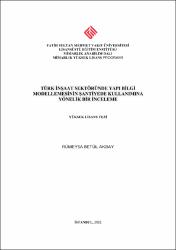Türk İnşaat Sektöründe Yapı Bilgi Modellemesinin Şantiyede Kullanımına Yönelik Bir İnceleme
Citation
AKBAY, Rümeysa Betül, Türk İnşaat Sektöründe Yapı Bilgi Modellemesinin Şantiyede Kullanımına Yönelik Bir İnceleme, Fatih Sultan Mehmet Vakıf Üniversitesi Lisansüstü Eğitim Enstitüsü Mimarlık Anabilim Dalı, Yayımlanmamış Yüksek Lisans Tezi, İstanbul 2021.Abstract
Son 50 yılda, inşaat endüstrisi diğer endüstrilere kıyasla oldukça az teknolojik yeniliğe sahiptir. İnşaat endüstrisinin parçalı doğası ve projelerin bir kereye özgü oluşu yeniliklere karşı direnç göstermesine neden olmaktadır. Değişime olan bu ilgisizliğin yanı sıra verimlilik ve performansı arttırma ihtiyacı uzun bir süredir bilinmektedir. Yapı bilgi modellemesi (YBM), binaların tasarlanma, inşa ve işletilme şeklini hızla değiştiren devrim niteliğinde bir teknoloji ve süreçtir.
Bu çalışmanın amacı tasarım aşamasında YBM süreçlerinde modellenen bilgilerin sahadaki personele hangi teknolojiler vasıtasıyla aktarıldığını tespit etmek ve sahadaki üretime sağladığı katkıyı incelemektir. Ayrıca Türk inşaat sektöründe YBM süreçleriyle yürütülen örnekleri incelemek ve sektörün yönelimini arttırmak için akademisyenler ve profesyoneller tarafından yapılan çalışmaları ortaya koymaktır.
Çalışmanın birinci bölümünde yapı bilgi modellemesi kavramı ele alınmıştır. Daha sonra yapı bilgi modellemesinin inşaat sektöründeki yerinden bahsedilmiş, projenin tasarım, yapım ve işletme safhaları incelenmiştir. Çalışmanın ikinci bölümünde yapı bilgi modellemesinin yapım sürecindeki uygulamalarına odaklanılmıştır. Yapı bilgi modellemesinin şantiyedeki organizasyona sağladığı katkılar araştırılmış, saha uygulamalarında YBM süreçlerine entegre olan diğer bilgi teknolojileri ele alınmıştır. Bu teknolojilerin incelendiği vaka çalışmaları tespit edilmiş, YBM süreçlerine nasıl entegre oldukları ve sürece sağladıkları katkılar incelenmiştir. Çalışmanın üçüncü bölümünde Türk inşaat sektöründe YBM uygulamaları incelenmiştir. İlk olarak Türkiye’deki proje örneklerinden bahsedilmiştir. Sektörde aktif olarak YBM teknolojilerini deneyimlemiş farklı paydaşları temsil eden beş profesyonelle yarı yapılandırılmış görüşmeler yapılmıştır. Yapılan görüşmeler ve literatürden elde edilen veriler karşılaştırılmıştır. In the last 50 years, the construction industry has had very few technological innovations compared to other industries. The fragmented nature of the construction industry and the one-off nature of projects make it resistant to innovation. This indifference to change, as well as the need to increase efficiency and performance, has long been recognized. Building information modeling is a revolutionary technology and process that is rapidly changing the way buildings are designed, built and operated.
The aim of this study is to determine the technologies through which the information modeled in BIM processes are transferred to the personnel in the field during the design phase and to examine the contribution it provides to the production in the field. In addition, to examine the examples carried out by BIM processes in the Turkish construction sector and to reveal the studies carried out by academicians and professionals in order to increase the direction of the sector.
In the first part of the study, the concept of building information modeling is discussed. Then, the place of building information modeling in the construction sector was mentioned and the design, construction and operation phases of the project were examined. The second part of the study focuses on the applications of building information modeling in the construction process. The contributions of building information modeling to the organization on the construction site were investigated, and other information technologies integrated into BIM processes in field applications were discussed. Case studies examining these technologies were identified, how they integrated into BIM processes and their contribution to the process were examined. In the third part of the study, BIM applications in the Turkish construction sector are examined. It was first mentioned examples of projects in Turkey. Semi-structured interviews were held with five professionals representing different stakeholders who have actively experienced BIM technologies in the industry. Interviews and data obtained from the literature were compared.



















